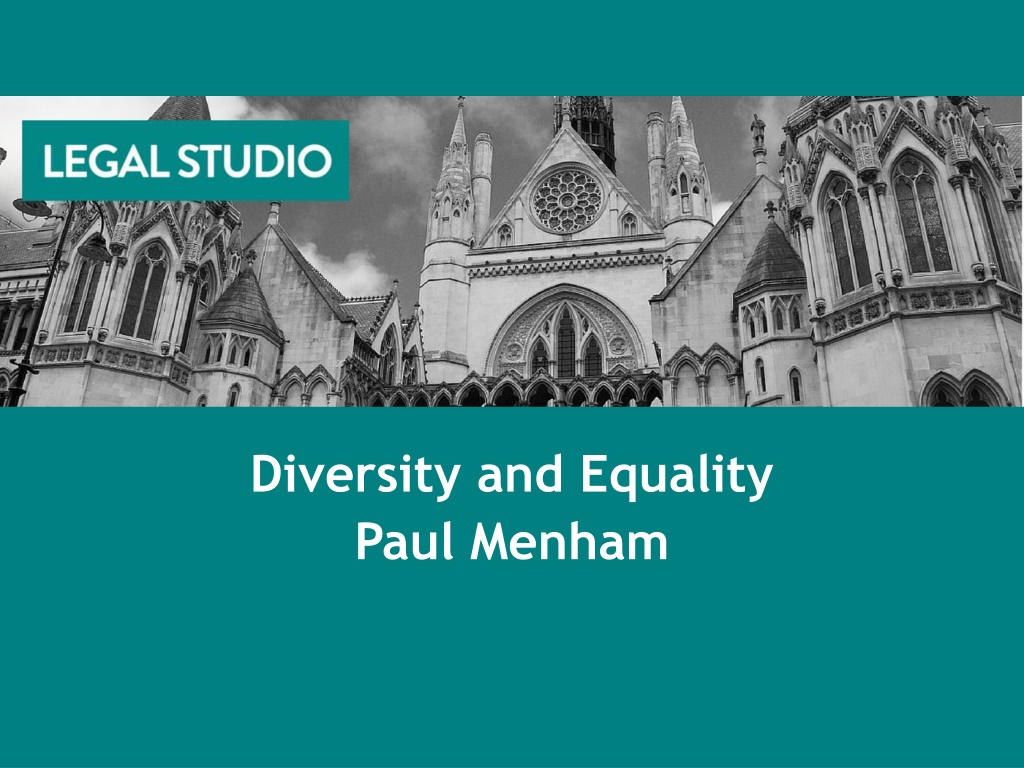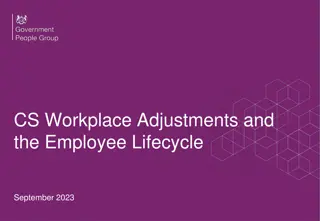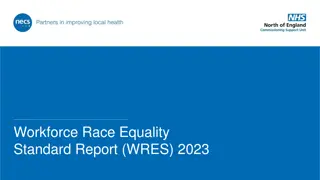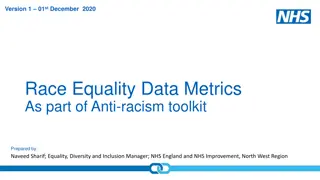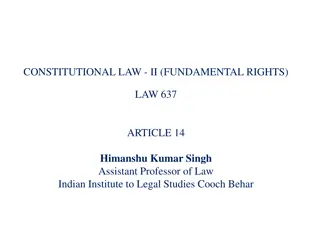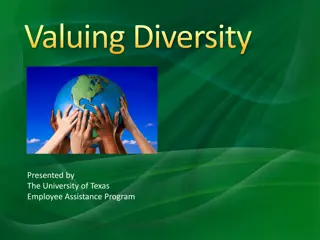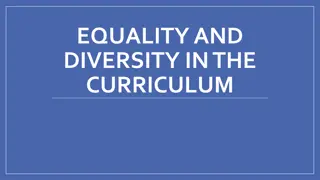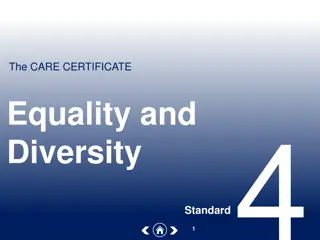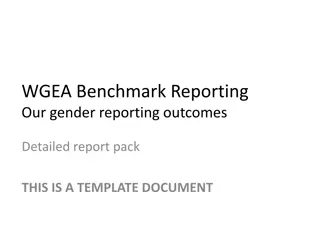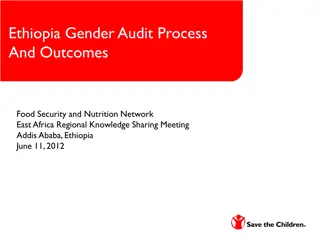Diversity and Equality in the Workplace
Explore the concepts of equality and diversity, the importance of compliance with laws, and the implications of discrimination in the workplace. Learn about company policies, discrimination types, and protected characteristics to promote a fair and inclusive work environment.
Download Presentation

Please find below an Image/Link to download the presentation.
The content on the website is provided AS IS for your information and personal use only. It may not be sold, licensed, or shared on other websites without obtaining consent from the author.If you encounter any issues during the download, it is possible that the publisher has removed the file from their server.
You are allowed to download the files provided on this website for personal or commercial use, subject to the condition that they are used lawfully. All files are the property of their respective owners.
The content on the website is provided AS IS for your information and personal use only. It may not be sold, licensed, or shared on other websites without obtaining consent from the author.
E N D
Presentation Transcript
Diversity and Equality Paul Menham
a Agenda Introduction and objectives What is meant by Equality & Diversity? What does the law require? Understanding unlawful discrimination Avoiding claims
Training Objectives Why attend? There are an increasing number of allegations relating to Equality & Diversity To ensure you have an understanding of why it is important to comply with the law To provide a basic knowledge of the law that underpins these concepts To avoid claims and minimise exposure
nd diverity? What is Equality and Diversity? Equality is a term used to denote equality of opportunity for all workers and employees so that they can: work free from prejudice and discrimination have the opportunity to fulfil their potential have their own beliefs and values respected. Diversity means difference . It is about valuing variety and the benefits of individual differences (not necessarily treating everyone the same ) The principles are underpinned by the anti-discrimination laws in the Equality Act 2010.
Why is it important? The ethical case The business case A diverse workforce means a wider range of resources, skills and ideas providing a competitive edge Discrimination record may be significant Q: Can you think of other business reasons? The risk of legal claims (with unlimited compensation)
Company Policy What is your Policy? Equality & Diversity Policy Prohibits discrimination Explains types of discrimination Managers/Directors must set standards of behaviour All breaches of the policy should be taken seriously and fully investigated Breaches of the policy may be subject to disciplinary action up to and including dismissal (where appropriate)
What is discrimination? Discrimination can occur on one of 9 unlawful grounds, known as Protected Characteristics Sexual Orientation Sex Marital / Civil Partnership Status Age PROTECTED CHARACTERISTICS Gender reassignment Race Disability Pregnancy and Maternity Religion or belief
Who is protected? JOB INTERVIEWEES CONTRACTORS APPLICANTS AGENCY WORKERS EMPLOYEES EX EMPLOYEES Cradle to grave
Who can be liable? The Company Managers Other Employees
Who can be liable? The Company even if not aware of the discrimination Individuals (managers, colleagues) Any discriminatory conduct in the course of employment Wide test Can include work social events and client events
Tribunal Claims Key points about discrimination claims.. INTERNAL AND EXTERNAL PR ISSUES NO CAP ON COMPENSATION NO SERVICE REQUIREMENT AWARDS FOR INJURY TO FEELINGS, AGGRAVATED DAMAGES AND PERSONAL INJURY MANAGEMENT TIME
Types of discrimination? DIRECT INDIRECT DISCRIMINAION DISCRIMINATION HARASSMENT VICTIMISATION 12
Direct Discrimination Less favourable treatment of one person than another person (whose circumstances are materially the same) because of a protected characteristic NB there may not be proof that the treatment is due to a protected characteristic, inferences of discrimination can be drawn if an employer cannot give an adequate explanation for the treatment 13
Direct Discrimination Example Sue is 57 years old and applies for promotion. She is turned down. The job is given to Mike who is 35 years old. Mike and Sue have the same experience, skills and qualifications. Sue can claim age discrimination against the Company as she has been treated less favourably than Mike. Her employer would need to be able to convince a tribunal that it had valid reasons for promoting Mike over Sue which were unrelated to age. Q: Can you think of any other examples? 14
Be aware of Perception & Association Perceived characteristic e.g. straight male is a victim of homophobic banter Perception Characteristic of close associate e.g. less favourable treatment because of son s disability Association 15
Indirect Discrimination Indirect Discrimination Indirect discrimination occurs when there is a working arrangement, policy or practice that applies equally to all but particularly disadvantages members of a protected group and a particular individual within that group Example: A full time female employee who has young children requests part time working hours. Her request is turned down. She brings a claim for indirect sex discrimination on the basis that she is disadvantaged by the requirement to work full time, as are the protected group (women who have childcare responsibilities).
Indirect Discrimination Indirect discrimination can be justified (and so not unlawful) if: there a legitimate business aim behind the arrangement; and the arrangement is a proportionate means of meeting that aim Example The full time female employee who has young children has a role where she interacts with the public from 9.00-5.00pm. The role reasonably requires continuity from the same member of staff, and is therefore incapable of being carried out on a part time or job share basis.
Indirect Discrimination Consider: Is there a legitimate aim? Does the policy achieve that aim? Is there some other way you can achieve that aim without discriminating? Balance it out Needs of the business Needs of the individual Vs
ictimisation: examples Victimisation Victimisation is: Treating a person less favourably than you would treat another because they have: complained about discrimination; been involved in a complaint about discrimination; or intend to do either of the above. Examples refusal to provide a reference because they alleged discrimination cold shouldering an employee who has brought a discrimination claim
Discrimination: Quiz Discrimination Quiz Which of the following could be discrimination? Requiring cleaning staff to be able to speak, read and write English fluently? Not promoting a female employee because she is pregnant and will need to take maternity leave soon after she would start the new role. Banning headgear for customer service advisors in a call centre? Team socials are held at 6 pm on Friday evenings at the local pub. A manager openly discussing an employee s discrimination complaint with other members of staff?
harassment Harassment Harassment is: Unwanted conduct related to a protected characteristic which has the purpose or effectof violating the victim s dignity; or creating an intimidating, hostile, degrading, humiliating or offensive environment for the victim. Example: A woman has a total disregard for men in general. She refers to them as male chauvinist pigs, sometimes making snorting noises in their presence and saying things like going home to your sty? when a male is leaving work.
Harassment Harassment can be: verbal or physical abuse jokes and banter abusive or derogatory emails / texts exclusion gradual removal of responsibilities Other examples?
harassment Harassment Key points about harassment: No need for the victim to make it clear it is unwanted A one-off incident can amount to harassment Banter is not a defence Harassment can be unintentional and the victims viewpoint must be taken into account (the test is whether it is reasonable for the conduct to have had that effect) The conduct need not be directed at a particular employee for it to amount to harassment Beware of assumptions and stereotyping e.g. Women are bad drivers .
harassment Harassment Example Male members of staff download pornographic images on to their computers in an office where a woman works. She may make a claim for harassment if she is aware that the images are being downloaded and the effect of this is to create a hostile and humiliating environment for her. It is irrelevant that she doesn t actually see the images, the male members of staff did not intend to upset the woman (and did not intend for her to know that they were being downloaded), and that they considered the downloading of images as "having a laugh".
Harassment: Quiz (1) Harassment Quiz True or False? Harassment can be unintentional? Behaviour is only harassment if a reasonable person would judge it to be so? Harassment must be a series of two or more incidents? The employer will not be liable for harassment if the employee has not complained about it before?
Harassment Quiz Harass True or False? An employee can be personally liable for harassment of another? The employer will not be liable for harassment by one employee of another if it did not know about the behaviour? Harassment must be directed at the individual to be unlawful?
Disability Discrimination Additional protection for disabled employees: duty to make reasonable adjustments and discrimination arising from disability Not enough time today to go into any sort of detail. Be aware of definition of disability TOP TIP: Consider all employees with long term health conditions as disabled
Disability Discrimination Definition of disability: "A person (P) has a disability if P has a physical or mental impairment (at all), and the impairment has a substantial (more than minor) and long-term (12 months or more) adverse effect on his ability to carry out normal day-to-day activities". - Section 6(1) Equality Act 2010 Some conditions are deemed disabilities from day 1
Avoiding Claims Discrimination claims have uncapped compensation usually loss of earnings plus an injury to feelings award (of up to 33,000) No requirement for two years service to bring a claim Huge amounts of management time Significant legal costs (Costs can be very reasonable with some providers)
Avoiding Claims Have an Equality & Diversity Policy Be familiar with and follow your Equality & Diversity Policy Avoid making assumptions in your decision making Train your staff (particularly managers) a statutory defence to discrimination claims is possible if the workforce has been appropriately trained
Avoiding Claims Deal with complaints fairly, openly and promptly Take appropriate disciplinary action where behaviour is inappropriate Act consistently in decision making and ensure you have a clear and full paper trail
Questions Any Questions?
Legal Studio For more information on our services or further advice regarding diversity and equality then please contact: Web: www.legalstudio.co.uk Email: pcm@legalstudio.co.uk Tel: 0113 247 3802 Mobile: 07548 234 766
